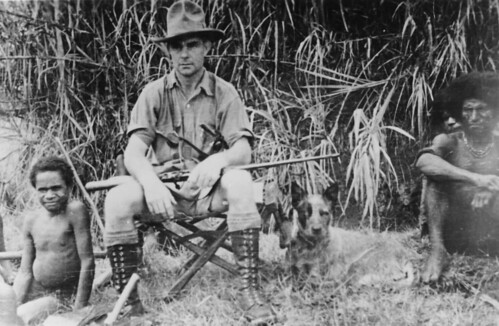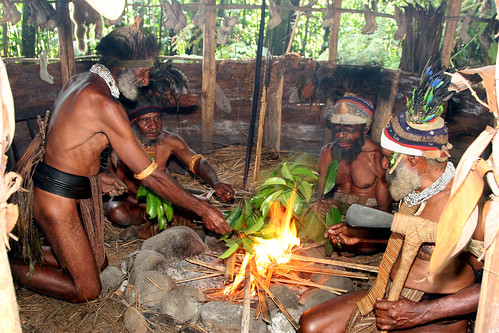PNG: First Contact
alternate title: The Golden Wahgi
When gold was discovered in the highlands, it brought a million people into contact with the rest of the world. Roderick Eime traces the history of that first contact.
“The whiteman came from there,” said the old village elder gesturing toward the end of the valley, ‘we’d never seen such a thing. We were scared, confused.”
This scene played out time and time again as the Leahy brothers and their caravan of trackers and porters made their way to the unexplored inland in search of gold.
There were hints of gold lying in and around Papua New Guinea as far back as the mid-19th century and each new find was accompanied by a flurry of activity, but it wasn’t until 1926 that large commercial quantities began to be excavated by modern machinery. Even then, it wasn’t enough and exhausted diggers soon returned to Australia to join the growing lines of jobless as the Great Depression took hold.
Michael James “Mick” Leahy, born at Toowoomba in 1901, was no ordinary man, even among the hardy Australian bushmen of the time. Always rough and ready, “Masta Mick” as he would later be known, began a dynasty that persists to this day.

Mick Leahy in PNG
In 1930, Mick, along with fellow prospector, Michael Dwyer, began a series of prospecting trips into the interior beginning with the Ramu tributaries and culminating in the now famous discovery of the Wahgi Valley around today’s Mount Hagen. By this time Mick’s brothers, James and Daniel were well entrenched in the business, following him everywhere.
“They say Mick had the gold fever,” recalled Dan during the making of the 1983 Academy Award-nominated documentary ‘First Contact’, “well, we all had it.”
Sure, they found gold and lots of it, but Mick was also interested in documenting the discovery of the million or so previously unknown inhabitants of these vast, fertile valleys. His explorations grew more audacious and, after a few violent encounters, learned to travel well-armed and provisioned. He also took cameras.
“When the white man thought our leader was going to attack, he shot him,” recalls the same villager as he recounts that event to the filmmakers.
“The only reason we killed was to defend ourselves and all our carriers,” says Dan in defence of their actions,” if we hadn’t they’d have killed the lot of us.”
The documentary, made by Sydney filmmakers, Bob Connolly and Robin Anderson is a fascinating recounting of the heady days of prospecting and discovery in the wild highlands of Papua New Guinea. Hours of Leahy’s 16mm film were recovered and restored and then the crew returned to the Wahgi Valley and found surviving members of his expeditions and villagers who remember their first confrontations with these strange white ghosts.

Melpa men of the Tokua village near Mt Hagen, Papua New Guinea perform a moka where they exchange gifts and confer on village matters.
Today visitors to Mount Hagen and the surrounding valleys will meet people who, just two generations ago, were completely unknown to the outside world. While comparisons to the Leahy brothers’ empire might be regarded as overly flattering, Newcastle entrepreneur, Bob Bates, has created his own minor dynasty with Trans Niugini Tours.
For over 45 years, the Bates family have lived and worked in Papua New Guinea with their head office on the original site in Mount Hagen. Their network now extends beyond the initial modest 4WD safaris, to aircraft charters, wilderness lodges and river cruises. Son, Andrew, handles the company’s marketing and travels back and forth from the family property near Newcastle.
“Dad’s a bit shy really,” he notes with a wry grin and nods toward Bob who ducks out the back door, “but he’s got lots of stories to tell.” I’m sure! Bob is a regular around town and still drives an original Range Rover he bought new in the ‘70s.
Although I spend one night at the centrally located Highlander Hotel in downtown Mt Hagen, the remainder of my stay is at the superbly located Rondon Ridge, a new Bates family lodge overlooking the entire Wahgi Valley, or so it seems. Spacious and intriguingly decorated with Highland and Sepik art, it is powered by its own hydroelectricity plant and the kitchen serves organic salads and vegetables gathered from the many local market gardens. The avocadoes are to die for.
The Wahgi Valley is the domain of the Melpa people and their unique language is heard in the villages, markets and busy bus stops around town. PNG has over 800 unique languages, a legacy of its millennia of isolation and territorial nature of the many tribes. Even Leahy’s Papuan men had no way of communicating with the Melpa during their historic first encounters and everything was negotiated with sign and body language.
“If we wanted a pig for dinner, we’d grunt ‘oink, oink’ like that,” said Toa, one of Mick’s ‘boys’ to the camera, “and we’d buy the pig with shells.” The Melpa had never seen shells and they instantly became currency and were negotiable for all manner of goods ... and services.
Joseph, my driver and guide, takes me on a series of jaunts throughout the region visiting villages, gardens, markets and points of interest like the Gatak River, where the Leahy brothers found much of their gold.
“My father found a big nugget for Masta Mick,” recalls Joseph, pointing over to the river. Joseph’s dad was just a boy then, working for the Leahys.
Villagers in traditional attire demonstrate their ancient methods of agriculture, planting and harvesting. We’re invited to try roasted sweet potato and it’s delightful. The Wahgi Valley is now recognized as one of the first areas of human farming, dating back 9000 years and the Kuk Swamp site is UNESCO World Heritage listed.
The lodge also has a series of walking trails into the surrounding forest. Its secondary growth apparently, regenerated after Australian loggers came through and cleared out all the oak and beech in the ‘50s. Joseph shows me through the lodge’s orchid garden, protected by a moat from marauding pigs. It is their goal to collect every orchid that occurs in the valley, about 400, and they’re half way there now.
Mount Hagen is world away from the even the rest of Papua New Guinea, with obvious genetic differences between the coastal inhabitants. A visit there will help you understand the exhilaration experienced by Mick Leahy and his team who discovered both alluvial and cultural gold in the mist-enshrouded peaks of the Wahgi.
If you go:
Trans Niugini Tours [www.pngtours.com] offer an extensive range of tours and excursions throughout Papua New Guinea. +675 542 1438 service@pngtours.com
[as supplied] Getting there: Pacific Blue offer flights from Sydney to Port Moresby (connecting via Brisbane) with fares starting from $319 per person, one way on the net. Direct flights are also available from Brisbane on Mondays, Wednesdays, Fridays and Sundays from $239 per person, one way on the net. If you're looking to keep entertained, simply hire the digEplayer. Your own personal in-flight system features movies, TV shows and a board array of music for an additional $20. If you fancy extra leg room, book the Blue Zone seating option for an extra $45. Check out www.flypacificblue.com for current specials, bookings and all your travel needs.
Both Air Niugini and Airlines of PNG fly daily to Mount Hagen.
Best time to visit: Mount Hagen Show is a cultural feast staged every August.
Further reading: “First Contact” available on DVD by Arundel Films